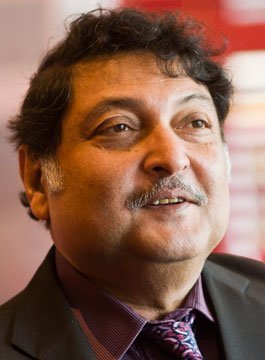Sugata Mitra is Professor Emeritus at NIIT University Rajasthan, India.
With a PhD in theoretical physics, he retired in 2019 as Professor of Educational Technology at Newcastle University, UK.
The Times newspaper has described him as a “Global Education Superstar“.
Sugata works in the areas of Cognitive Science, Information Science and Educational Technology.
His interests include Children’s Education, Remote Presence, Self-organising systems, Cognitive Systems, Complex Dynamical Systems, Physics and Consciousness.
Hole in the Wall Experiment
Sugata Mitra conducted the Hole in the Wall (HIW) experiment in 1999. A computer was embedded within a wall in an Indian slum at Kalkaji, Delhi and children were allowed to use it freely.
The experiment proved that kids could be taught computers very quickly without formal training. Sugata termed this Minimally Invasive Education (MIE).
The HIW experiment has been repeated in many places.
He is the recipient of many awards and honorary doctorates from India, the UK, the USA and many other countries worldwide.
The Hole in the Wall experiment has left a mark on popular culture. Indian diplomat Vikas Swarup read about Mitra’s experiment and was inspired to write his debut novel, which became the Oscar-winning movie of 2009 – Slumdog Millionaire.
Sugata Mitra is credited with more than 25 inventions in cognitive science and educational technology. He was awarded the prestigious Dewang Mehta Award from the Government of India for Innovation in Information Technology in 2003.
Amongst many other awards, he was awarded the 1-million-dollar TED Prize in 2013.
Starting with molecular orbital computation in the 1970s, Mitra discovered that the structure of organic molecules determines their function more than the constituent atoms.
After a PhD in Theoretical Solid State Physics from the IIT, Delhi, he researched energy storage systems, first at the Centre for Energy Studies in the IIT and then at the Technische Universität, Vienna, Austria. Sugata’s research resulted in a new design for Zinc-Chlorine batteries.
His interests in the flow of electricity through biological systems, a consequence of his PhD research on exciton dissociation in organic semiconductors, led to a seminally speculative paper on why the human sense organs are located where they are.
His interest in computer networking led him towards the emerging systems in printing in the 1980s.
He set up India’s first local area network-based newspaper publishing system in 1984 and predicted the desktop publishing industry. This led to the invention of LAN-based database publishing, and he created the “Yellow Pages” industry in India and Bangladesh.
His interest in the human mind once again led him into the areas of learning and memory, and he was amongst the first in the world to show that simulated neural networks can help decipher the mechanisms of Alzheimer’s disease.
He was amongst the first people in the world to invent Voluntary Perception Recording (a continuously variable voting machine) and a hyperlinked computing environment in 1990, several years ahead of the Internet.
Sugata Mitra Speaking topics:
- Role of Technology and Education in a Sustainable Society
- Future of Education
- Cognitive Science
- Self-Organised Learning Environments
- Sustainable Learning
- Youth, Education and Social Transformation

